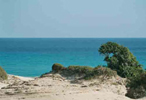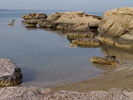| |
|
|
| |
|
|
|
Site
information & climate |
Location:
Cyprus is divided into three major regions :- 1.The Troodos
Mountains or the Southern Range, occupying the central part
of the island,2.The Girne Mountain Range, or the Northern
Range, along the northern coast.3.The Mesaoria Plain, running
from Guzelyurt Bay in the west to Gazi Magosa Bay in the
east and separating the two highland areas.
The narrow coastal terraces of the Northern Range are very
fertile. In contrast to the jagged peaks, the sides are
wooded. Below the woods there is a band of arid land, up
to 9 km wide in places on the south side of the range though
quite narrow on the north side. The eastern extremity of
the North Coast is the Karpaz peninsula. The peninsula,
its backbone being a continuation of the Northern Range
for another 60 km appearing as low hills surrounded by flat
plateaux and deep valleys. The vegetation on the two sides
shows a condiderable difference, the northern slopes being
covered with pine and cypress forests whilst the southern
slopes bear garrigue and maquis scrub down to the semiarid
plains of the Mesaoria. |
 |
| |
The climate of the island
is of Mediterranean type with very hot dry summers and relatively
cold winters. .Most of the rainfall is between December
and January. Climate of coastal areas is less extreme than
farther inland, due to the sea on atmospheric humidities
.
The sea temperature itself never falls below 16ºC.
(January and February); in August it can rise to 28 ºC.
From mid-May to mid-September the sun shines on average
around 11 hours. Temperatures can reach 40º C. On
the Mesaoria Plain, although lower on the coasts, with
a welcome north-westerly breeze called "Poyraz".
The skies are cloudless with a low humidity, 40 - 60 per
cent, thus the high temperatures are easier to bear.
During the wet winter months Cyprus is a green island.
However, when June arrives the landscape at the lower
levels assumes the brown, characteristic of its summer
face. The forests and the vineyards in the mountains,
remain green.
|
| |
Wildlife,
flora & fauna
|
| There are two main types of sea-turtles nesting
along the coasts of Northern Cyprus; these are: Caretta-Caretta
(Sini Kaplumbagasi), and Chelonia-Mydas (Yesil Kaplumbaga).
They are both are listed as endangered species and under
strict protection. The laying season of the sea-turtles
is from mid-May until mid-October. Turtles nest by digging
the sand 30-60 cm deep. If the eggs are not harmed, baby
turtles crawl down to the sea in about 55-60 days.Those
baby turtles that manage to survive, come back to lay in
30 years time. One out of four thousand baby sea-turtles
manage to survive until their adolescence.
During their lifetime, sea-turtles are especially vulnerable
to external danger, such as other sea or land animals, noise,
and pollution. The Enviromental Protection Office of Northern
Cyprus, together with envioment related NGOs [such as Society
for Protection of Marine-turtles, Green Peace Movement of
N.Cyprus, and N.Cyprus National Trust] are very active in
protecting the sea turtles
For more information contact:
Department of Enviromental Protection,
Ministry of Agriculture and Natural Resources,
Nicosia,
North Cyprus,
via Mersin 10, Turkey
Tel: 00-44-392-228 29 35 / 228 29 95
Fax: 00-44-392-228 28 96 |
|
|
|
|
Website
designed by Schmetterling Productions
|




